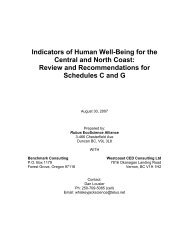Northern Plan Area Economic Opportunities and Barriers Study
Northern Plan Area Economic Opportunities and Barriers Study
Northern Plan Area Economic Opportunities and Barriers Study
You also want an ePaper? Increase the reach of your titles
YUMPU automatically turns print PDFs into web optimized ePapers that Google loves.
Hecate Lowl<strong>and</strong>s<br />
• may have to ship raw logs to generate revenue<br />
• environmental boycott of Central Coast wood products may be a barrier<br />
• Bella Bella <strong>and</strong> Denny Isl<strong>and</strong> on zone 2 hydro power rates which may be prohibitive<br />
to cost of product development<br />
• target species such as cedar may be unavailable due to being in licensee chart area<br />
• species available for communities may not be of sufficient quality or quantity for<br />
successful development<br />
• non First Nations within the area do not have access to same opportunities as First<br />
Nations<br />
Refer to Table 1D for an overview of forestry opportunities <strong>and</strong> barriers.<br />
Botanicals: Outer Coast<br />
Hecate Lowl<strong>and</strong>s are within the Central Very Wet Hypermaritime Coastal Western<br />
Hemlock Variant (CWHvh2) biogeoclimatic zone. The dominant vegetation is western<br />
red cedar, mountain <strong>and</strong> western hemlock <strong>and</strong> yellow cedar. True fir, lodgepole pine <strong>and</strong><br />
sitka spruce are secondary species. The forest understory includes salal, Alaskan<br />
blueberry, false azalea, deer fern, step moss <strong>and</strong> lanky moss with minor amounts of fernleafed<br />
gold thread, skunk cabbage <strong>and</strong> green sphagnum.<br />
The adjacent biogeoclimatic zones are the CWHvh1, CWHvm1 <strong>and</strong> MHwh. The<br />
following compares the vegetation cover to that of the CWHvh2.<br />
CWHvh1:<br />
• less yellow cedar <strong>and</strong> lodgepole pine, more true fir<br />
• rare fern-leafed goldthread, skink cabbage <strong>and</strong> green sphagnum<br />
• evergreen huckleberry present<br />
CWHvm1:<br />
• rare yellow cedar, lodgepole pine, fern-leafed goldthread, skunk cabbage <strong>and</strong> green<br />
sphagnum<br />
• less red cedar <strong>and</strong> salal, more true fir<br />
• some Douglas fir on dry south facing slopes<br />
MHwh:<br />
• over 50% mountain hemlock with no salal.<br />
In the past ten years the interest in forest botanicals has risen dramatically. The scientific<br />
acknowledgement <strong>and</strong> growing popularity of alternative <strong>and</strong> traditional medicine, an<br />
ageing population concerned with nutrition, the keen market for essential oils <strong>and</strong> a<br />
healthy floral industry is directing more attention to the harvesting of forest botanicals.<br />
23

















